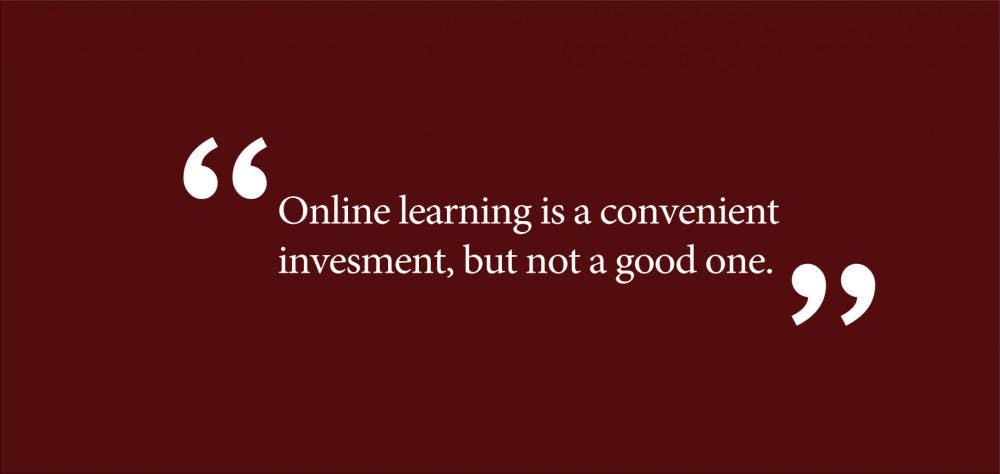Many American school districts have made a massive mistake, and you should take note. This mistake is not only wasting your taxpayer money, but it’s also stifling opportunities for millions of American youth.
Struggling public schools have increasingly been investing in expensive e-learning packages rather than the necessities of quality education. While these online learning platforms may look good on paper, they degrade student learning and dehumanize the school environment.
The Providence Public School District is a prime example of this mis-investment.
PPSD faces many challenges. According to 2015 statistics, seventy-nine percent of its student population is low-income. School buildings are in a state of disrepair. A recent report on the district conducted by the Johns Hopkins Institute for Education Policy found that some school buildings are “even dangerous to students’ and teachers’ wellbeing.” As a direct result of this report, the state has begun a takeover of the school district.
Given the school district’s challenges, it’s not surprising that student achievement is low in Providence. The latest Rhode Island Comprehensive Assessment System test scores show that, across all grade levels, 90 percent of students are not proficient in math and 86 percent are not proficient in English Language Arts.
To attribute these poor results to inadequate funding would be an oversimplification. In fact, Providence spent over $18,300 per student in FY2018, placing it solidly above the median funding level of Rhode Island public high schools. For comparison, Barrington, which is widely regarded as one of the state’s best school districts, spent just over $15,000 per student in the same year. This is not to say that PPSD could not benefit from increased funding. PPSD students deserve more.
But the seeming contradiction seen in Providence of low-performing, highly-funded schools is actually a common phenomenon. State redistribution schemes and federal grants often bolster the budgets of struggling schools. So why don’t additional dollars always translate to increased student performance?
Unfortunately, school budgets may not go toward increased learning opportunities for disadvantaged students. Instead of fixing leaky roofs or introducing programs to better support high-needs students, Providence has invested in an online learning platform called Summit Personalized Learning.
Online learning is a convenient investment but not a good one. Policymakers can sell online learning as a push for modernization, using phrases like “21st century standards” or “learning for tomorrow.” School officials can rest easy knowing that e-learning platforms don’t join the teachers union and don’t require pensions, benefits or professional development.
The only problem is that e-learning packages don’t actually help students learn. Though a 2010 evaluation by the U.S. Department of Education found evidence of modest gains for students using online material, the study admitted that “few rigorous research studies of the effectiveness of online learning for K–12 students have been published.” Furthermore, the study’s results rested on a narrow definition of student success: standardized test scores. An alternative study found that e-learning had strong negative effects on student motivation. With these mixed results, one must evaluate the impacts of e-learning in each individual context.
The Johns Hopkins report found that, in Providence, “students almost universally disliked the Summit program.” In interviews, students reported that they were “burned-out through the over-use of screen time and bored.” Instead of using the software to do schoolwork, students often surfed the web, watched YouTube videos and listened to playlists. One student missed about half of the school year and still earned a B due to the way Summit is designed.
If your first instinct is to blame students for poor attention or for cheating the system, I challenge you to think more deeply. Have you ever taken an online course such as Coursera or Khan Academy? How long did you pay attention before you took a “quick Facebook break” that turned into 45 minutes of watching YouTube videos? Now imagine spending nine months each year in courses dominated by work on your computer with minimal oversight. In a room full of your friends. I’m not arguing that there’s no place for e-learning in our public schools. I’m arguing that its place should be limited, and its implementation should be strictly monitored.
In 2015, the e-learning market broke the $100 billion threshold. By 2025, it is projected to climb above $325 billion. Not all companies classified as e-learning necessarily supplant traditional learning — for example, Canvas is classified as an e-learning company. But entrepreneurs, encouraged by school districts’ uncritical money-throwing, are eager to produce the next shiny online package sold in the name of developing our nations’ youth. In the process, we turn some schools into a glazed-over slog from computerized classroom to computerized classroom.
Students deserve better.
Struggling schools need to invest their budgets in services that will support their high-needs students. In many Providence schools, roofs are leaking and the heat doesn’t work properly. Shouldn’t adequate shelter be a prerequisite to learning? High school students in Providence receive bus passes only if they live beyond a two-mile radius of their school. In the winter, many students need to trudge well over a mile in the snow to get to class. Would it be that difficult to ensure that all students have guaranteed transportation? These issues seem like they should be prioritized over investment in pricey e-learning packages.
Brown University students, if you plan to go into education technology, think long and hard about how your work will translate to the classroom. Ensure that your product supplements, rather than supplants, classroom learning. If you plan to work in education policy, think about how each investment will affect individual students. Heck, you could even listen to students themselves. The Providence Student Union has a Student Bill of Rights that provides a good starting place.
Asher Lehrer-Small ’20 can be reached at asher_lehrer-small@brown.edu. Please send responses to this opinion to letters@browndailyherald.com and op-eds to opinions@browndailyherald.com.



